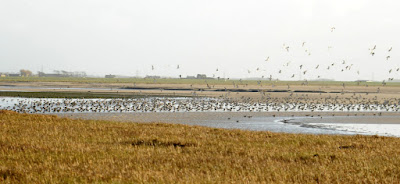....well something like that!
Lesser Black-backed Gull. Conder Pool. Pete Woodruff.
The water level has begun to fall on Conder Pool and the nest boxes can now be seen resting on the island again, ready and waiting for the Common Terns to arrive again this year, though this LBBG and it's mate always seem to show an interest in the island and its boxes, but they never seem to produce any results.
Conder Pool was fairly quiet on Friday, though to contradict that comment, 56 Curlew and 26 Wigeon were of note, with 4 Little Grebe seen. A Spotted Redshank was on the marsh with Redshank escaping the high tide. The Lune Estuary held two excellent counts, with up to 1,000 Black-tailed Godwit and 800 Knot present, 52 Goldeneye were also counted.
At Cockersands, the Whooper Swan herd are still around, and whilst trying to get a reasonable accurate count from a viewpoint behind Lower Bank House, 2 Barn Owl were hunting together again, and in Bank Houses horse paddock I counted 15 Blackbird. As I walked along the headland the Turnstones were all along the stony shore as the tide dropped, and 18 Eider off Plover Scar were the first I've seen here since I saw six almost five months ago on 8 October 2015.
Off Crook Farm, I estimated up to 1,250 waders feeding, broken down to 630 Black-tailed Godwit, 450 Knot, 170 Dunlin, a Grey Plover not unusual as a single, and a Golden Plover most unusual as a single.
The Grey Partridge.
The Grey Partridge.
Grey Partridge Geoff Gradwell
It was good to meet Maurice and Barry on Friday, and during the conversation I was asked when I last saw Grey Partridge, a species on the Red List, and declining nationally. I wasn't able to say at the time, but having now searched my records I note the last time I saw GP was 13 May 2014 when I had two birds at Cockersands. I'm not holding my breath for my next sighting.
And finally....
I was pleased to see a Little Stint had been found - Ian Hartley - yesterday, seen on the Lune Estuary from the car park at Conder Green with Dunlin and presumed to be the same bird found in the Cocker channel downstream from the railway bridge Monday 18 January....I'll second that presumption.
Thanks for the Grey Partridge Geoff....excellent.
And finally....
I was pleased to see a Little Stint had been found - Ian Hartley - yesterday, seen on the Lune Estuary from the car park at Conder Green with Dunlin and presumed to be the same bird found in the Cocker channel downstream from the railway bridge Monday 18 January....I'll second that presumption.
Thanks for the Grey Partridge Geoff....excellent.





























